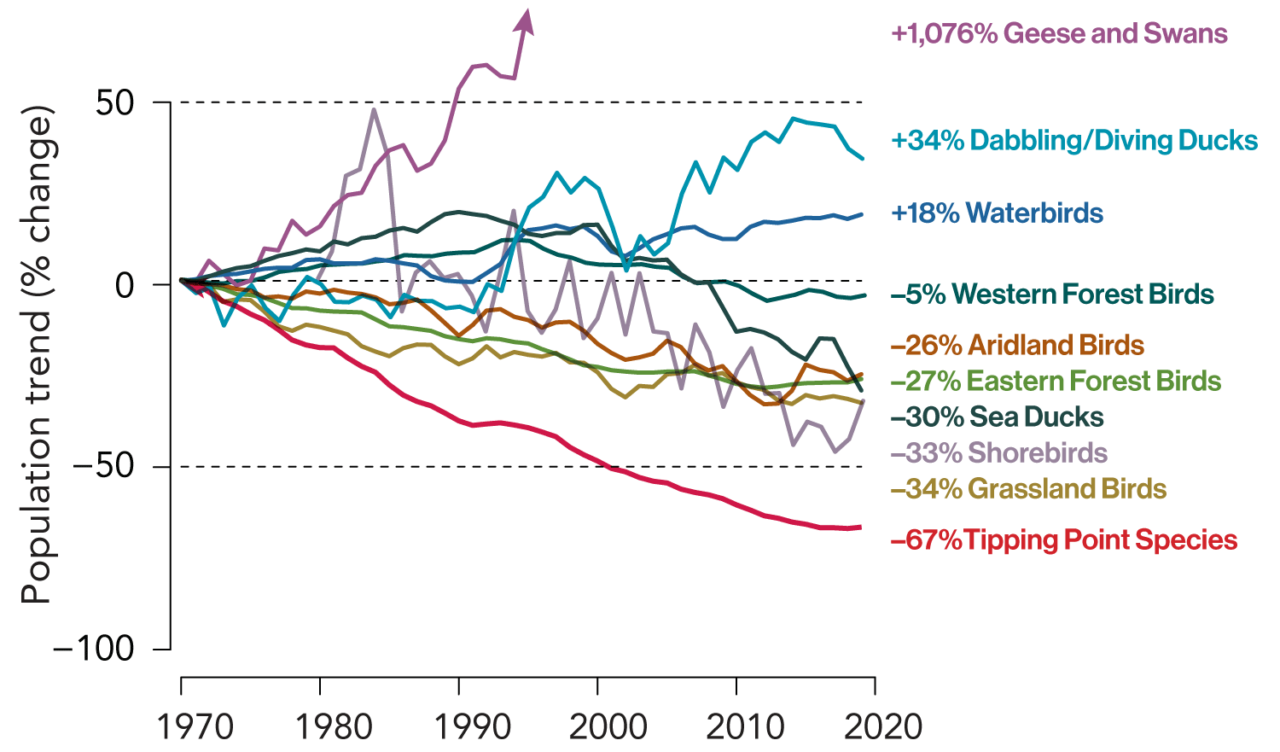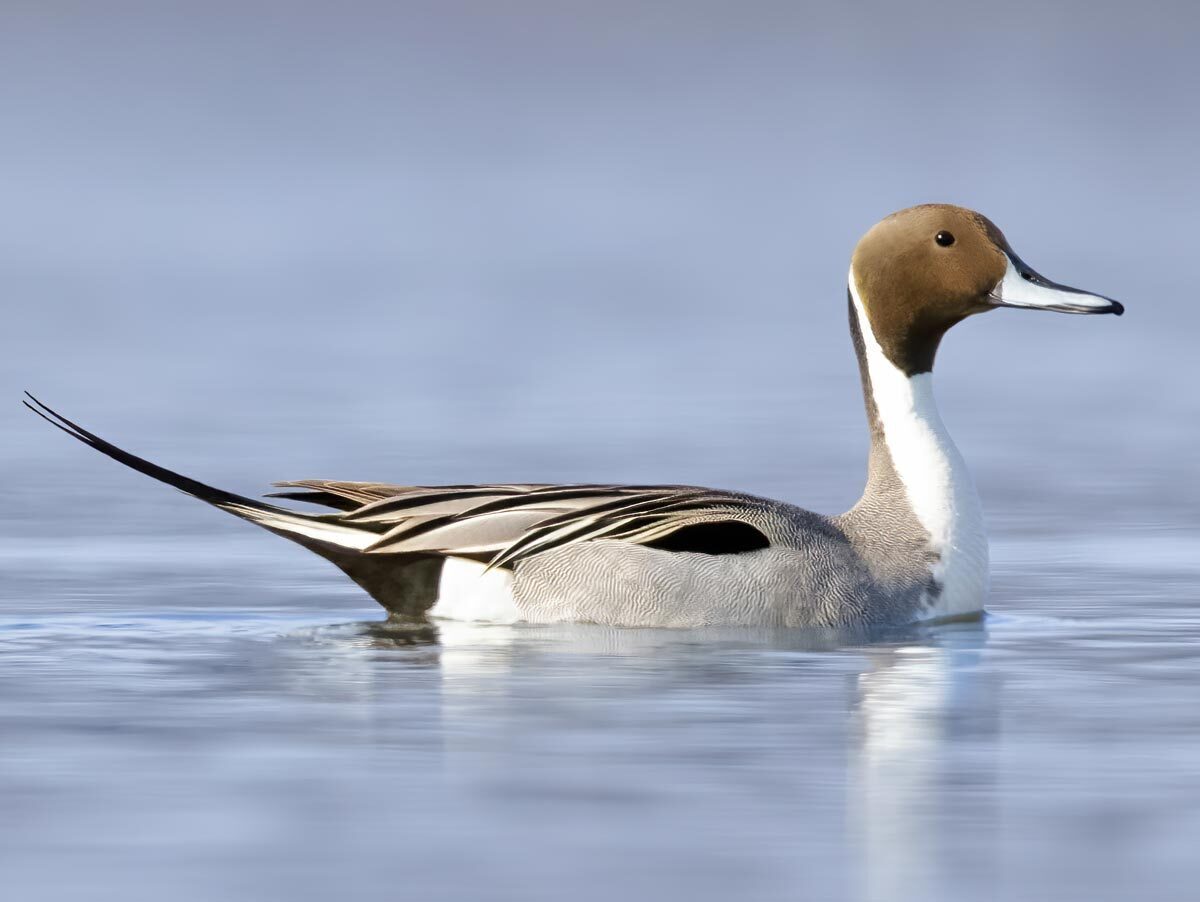News Room
For release Wednesday, October 12, 2022, 11:00 a.m. Eastern Time
2022 U.S. State of the Birds Report Reveals Widespread Losses of Birds in All Habitats–Except for One
In 50 years, birds have increased overall in wetlands, a singular exception that shows the way forward for saving birds and benefiting people
Photos, sounds, graphics, and B-roll for this story are available to reporters.

Ithaca, NY—A newly released State of the Birds report for the United States reveals a tale of two trends, one hopeful, one dire. Long-term trends of waterfowl show strong increases where investments in wetland conservation have improved conditions for birds and people. But data show birds in the United States are declining overall in every other habitat—forests, grasslands, deserts, and oceans.
Published by 33 leading science and conservation organizations and agencies, the 2022 U.S. State of the Birds report is the first look at the nation’s birds since a landmark 2019 study showed the loss of 3 billion birds in the United States and Canada in 50 years.
Findings included in the report:
- More than half of U.S. bird species are declining.
- U.S. grassland birds are among the fastest declining with a 34% loss since 1970.
- Waterbirds and ducks in the U.S. have increased by 18% and 34% respectively during the same period.
- 70 newly identified Tipping Point species have each lost 50% or more of their populations in the past 50 years, and are on a track to lose another half in the next 50 years if nothing changes. They include beloved gems such as Rufous Hummingbirds, songsters such as Golden-winged Warblers, and oceanic travelers such as Black-footed Albatrosses.

“The rapid declines in birds signal the intensifying stresses that wildlife and people alike are experiencing around the world because of habitat loss, environmental degradation and extreme climate events,” said Dr. Amanda Rodewald, director of the Cornell Lab of Ornithology’s Center for Avian Population Studies. “Taking action to bring birds back delivers a cascade of benefits that improve climate resilience and quality of life for people. When we restore forests, for example, we sequester carbon, reduce fire intensity, and create habitat for plants and animals. By greening cities, we provide heat relief, increase access to recreation, and create refuge for migrating birds.”
The report used five sources of data, including the North American Breeding Bird Survey and Christmas Bird Count, to track the health of breeding birds in habitats across the United States.
“From grassland birds to seabirds to Hawaiian birds, we continue to see that nearly all groups of birds and types of bird habitat have declined significantly,” said Martha Williams, director of the U.S. Fish and Wildlife Service. “The one group that is seeing an increase in population size are wetland-dependent birds, including waterfowl.”

“While a majority of bird species are declining, many waterbird populations remain healthy, thanks to decades of collaborative investments from hunters, landowners, state and federal agencies, and corporations,” said Dr. Karen Waldrop, chief conservation officer for Ducks Unlimited. “This is good news not only for birds, but for the thousands of other species that rely on wetlands, and the communities that benefit from groundwater recharge, carbon sequestration, and flood protection.”
The report suggests that applying that winning formula in more habitats will help birds and natural resources rebound.
“The North American Waterfowl Management Plan, Federal Duck Stamp Program, grants from the North American Wetlands Conservation Act, and regional Joint Ventures partnerships are all part of a framework that has a proven track record with restoring and protecting wetland-dependent species,” said Williams of the U.S. Fish and Wildlife Service. “Now we want to use that precedent to work with our partners to restore bird populations, conserve habitat, and build a foundation for how we respond to the loss of other bird groups.”
Data show that conservation must be stepped up to reverse the biggest declines among shorebirds, down by 33% since 1970, and grasslands birds, down by 34%. Recognizing the need to work at bigger, faster scales, 200 organizations from across seven sectors in Mexico, Canada, the U.S., and Indigenous Nations are collaborating on a Central Grasslands Roadmap to conserve one of North America’s largest and most vital ecosystems—hundreds of million acres of grasslands.
“People have changed our grassland landscape and people are key to its future,” said Tammy VerCauteren, executive director of the Bird Conservancy of the Rockies and a representative of the Central Grasslands Roadmap. “Collectively, we are working to make a movement to save our grasslands and the people and wildlife that depend upon them. Together we can ensure Tribal sovereignty, private property rights, food security, resilient landscapes, and thriving wildlife populations.”
Given widespread declines, the report emphasizes the need for proactive conservation across habitats and species.

“Despite best hopes and efforts, 70 Tipping Point bird species have a half life of just 50 years–meaning they will lose half their already dwindling populations in the next 50 years unless we take action,” said Dr. Peter Marra, director of The Earth Commons—Georgetown University’s Institute for Environment & Sustainability. “What we’ve outlined in this State of the Birds is a recipe for how conservation biologists can work with communities and use surgical precision to solve environmental problems—blending new technology and data to pinpoint the cause of losses and to reverse declines while we still have the best chance—now, before more birds plummet to endangered.”
The report advises that meeting the tremendous need will require a strategic combination of partnerships, incentives, science-based solutions, and the will to dramatically scale up conservation efforts.
“Everyone can make a difference to help turn declines around,” said Mike Parr, president of American Bird Conservancy. “Everyone with a window can use simple solutions to prevent collisions. Everyone can help green their neighborhood and avoid using pesticides that harm birds. Everyone who lives in a neighborhood can bring the issues and solutions to their community and use their voice to take action.”
The 2022 U.S. State of the Birds report was produced by a consortium of government agencies, private organizations, and bird initiatives led by NABCI (North American Bird Conservation Initiative).
###
Media Kit
Media kit includes 2022 State of the Birds Report (PDF) and multimedia. Use of provided graphics, bird photos, sounds, and videos is protected by copyright and permitted only within stories about the content of the 2022 State of the Birds report. Redistribution or any other use is prohibited without express written permission of the Cornell Lab of Ornithology or the copyright owner.
List of regional and national experts available for interviews.
Media Contacts
Pat Leonard, Cornell Lab of Ornithology, pel27@cornell.edu, (607) 254-2137
Parker Williams, Ducks Unlimited, pwilliams@ducks.org, (251) 404-9444
William Bevil, Bird Conservancy of the Rockies, william.bevil@birdconservancy.org
Justine Bowe, The Earth Commons, Georgetown University, justine.bowe@georgetown.edu
Jordan Rutter, American Bird Conservancy, jerutter@abcbirds.org
Nicolas Gonzalez, National Audubon Society, ngonzalez@audubon.org
Annalisa Meyer, Smithsonian’s National Zoo and Conservation Biology Institute, meyeran@si.edu, (202) 904-8724
Mike Saccone, National Wildlife Federation, SacconeM@nwf.org, (202) 797-6634
Elva Manquera, Klamath Bird Observatory, ejm@klamathbird.org, (541) 908-0040
Caroline Murphy, The Wildlife Society, cmurphy@wildlife.org, (301) 968-1903
Additional Quotes from Organizations Releasing the 2022 State of the Birds Report
“America’s wildlife are in crisis with one-third of species at heightened risk of extinction. People and wildlife face many of the same threats, and we know that when we invest in conserving and restoring birds and other species, we also are investing in clean water, clean air, thriving ecosystems, and vibrant parks and public lands. The State of the Birds report is a clarion call for us all to help address the wildlife crisis and equip our state, Tribal, and territorial wildlife managers with the tools and funds they need to strengthen our shared stewardship of birds and the diversity of life that depends on them.”—Corina Newsome, associate conservation scientist, National Wildlife Federation
“What affects birds affects us, and birds are telling us they are in trouble. The Stateof the Birds Report underscores both the serious threats facing birds as well as opportunities to forge solutions that will benefit birds and the places they need. It also shows that what’s good for birds is good for people when it comes to addressing threats like climate change. Ensuring healthy landscapes across our forests, grasslands, wetlands, and more will help protect birds and people alike by storing carbon, providing essential habitat, and building more climate-resilient communities.”—Marshall Johnson, chief conservation officer, National Audubon Society
“This is not a time to be dismayed. This is a time for optimism, inclusivity, and action—the birds will not have it any other way. What the State of the Birds report tells us is investment in conservation works for both birds and people. With broad strokes of engagement across communities and proactive planning, we can collectively save birds and save ourselves.” —Nikki Belmonte, executive director, American Birding Association
“Birds are in trouble, but we all can help bring them back. Living bird-friendly makes your home and lifestyle better for birds and the planet. Our team at the Smithsonian is working hard to study and help conserve these magnificent feathered travelers, including creating an immersive exhibit opening in winter 2023 to further connect the public to understand and protect the grand phenomenon of bird migration.” —Dr. Scott Sillett, head of the Smithsonian Migratory Bird Center
“It’s critical that we bring the full weight of the collaborative bird monitoring community to these periodic assessments. We need to know how the birds of America are doing compared to previous assessments and the Avian Knowledge Network provides a partner-based data management platform that makes this easier and more efficient every time we do it. One thing that’s clear is that continued monitoring of the plight of birds will be crucial in our ongoing conservation efforts.” —Dr. Sam Veloz, director, Eco-Informatics and Climate Solutions, Point Blue Conservation Science, and steering committee member, Avian Knowledge Network
“Western forest restoration programs that are integrating bird conservation objectives with efforts to increase climate-, fire-, and water-security for front line communities provides just one of many such opportunities outlined in this year’s State of The Birds Report. This report highlights our work with Collaborative Forest Landscape Restoration Programs showing how a small investment in bird conservation specialists leverages huge forest restoration investments to ensure they pay off for birds and people. —Dr. John Alexander, executive director, Klamath Bird Observatory
